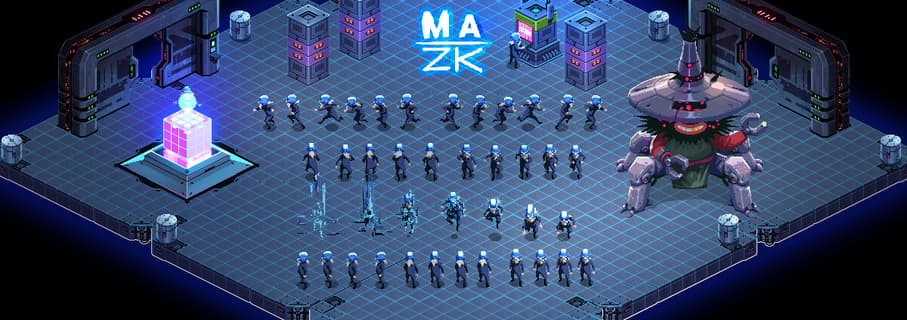Mazk was just lying there—no direction, no plan, no future roadmap. And yet, there I was, still opening file after file from the Mazk universe like some sort of digital archaeologist. This project has hoarded more artwork over the years than most indie studios manage to publish in a lifetime—and I had nowhere to show it.
I’ve been metaphorically pregnant with Mazk for almost seven years. And let me tell you: that’s a very long gestation period for any creative brainchild. Trying to carry a world in your head without being able to release it into the world? For an artist, that’s less "beautiful suffering" and more "slow artistic suffocation."
Jurij—a friend of mine who tends to orbit my office like a curious satellite—glanced over my shoulder one day. He casually dropped a suggestion: “You should check out Vampire Survivors. Might be a gameplay style that fits Mazk.” After he left, I fell down the rabbit hole of Let’s Plays. And that was it—the catalyst. The pixelated slap in the face I apparently needed. Suddenly, I saw a glimmer of how Mazk might actually work as a game. It felt like the universe handing me one last golden coin—one last shot at turning Mazk from a beautiful corpse of concept art into something players could actually play.
MAZK meets Vampire Survivors
I just sent Simon the following picture. I still remember how I was eagerly waiting for him to answer.
The answer came without hesitation. He just said, “Honestly? I think the idea’s really cool.”
And just like that—Mazk was back on the table. Again.
First things first: I had to wrap my head around how Vampire Survivors actually works. What makes it tick? What makes it addictive? Fortunately (or dangerously), that gave me the perfect excuse to do some very serious research—by which I mean playing it obsessively, day and night, under the noble banner of game design.
Hey, it’s not procrastination if you call it prototyping.
ITEMS! ITEMS! ITEMS!
Without much fanfare, Simon and I sat down and reopened the dusty vaults of Mazk. We sifted through what was already done—what pixel art could we salvage, what assets still had some fight left in them? The big question: how could we test things fast, with minimal effort?
We threw together a rough plan in Miro, just enough to give us direction without crushing us under the weight of premature perfectionism. I decided to start with the collected item system from Mazk—simple, contained, and a good playground for early mechanics.
And here’s the thing: sometimes the smartest move as an artist and game designer is to shamelessly build a clone. Not to copy, but to understand—to dissect mechanics, test your own ideas against proven ones, and build a foundation before trying to reinvent the wheel. Turns out, cloning isn't cheating. It's training.
Back To the Beginning
I grabbed everything I could use and started stitching together fresh mockups. Frankensteining old parts into new ideas—because hey, sometimes you don’t need to start from scratch; you just need to remember what you already built.

Simon fired up Godot and quickly whipped together a first test build. Nothing fancy—just enough to feel the heartbeat of something real again.
Just like that, we were back in the game. Quite literally.
The First Enemy
For a proper test, we needed an enemy. Something simple. Something smashable. None of my old assets really fit the bill, so I set my sights on designing a small crawl bot—a humble little troublemaker, just enough to shoot at, dodge, and debug our sanity with.
Our bot was starting to come to life—well, in a doomed, shoot-on-sight kind of way. It now had animations for idle, spawn, run, death, and a few other charming variations.
One bot morphed into a walking bomb, another picked up a taste for firearms. Simon gave them different behavior patterns—swarming, retreating, and all the twitchy little instincts a tiny enemy needs to feel like it’s making its own bad decisions.
That was a turning point. One of those moments.
We finally had clarity: we’d build a clone of Vampire Survivors—purely as a testing ground. Along the way, we’d see which features made sense for Mazk, and which ones we’d gladly toss out the airlock.It was a practical plan. It was doable. And, surprisingly... it actually felt right.
That was around summer 2024.
NEXT UP
DEV LOG 9. Tiles and Rooms

Illustrator, Animator & Conceptartist. Teaching characterdesign @HSLU Luzern. Livepainter for german comedians and passionate pixelgame creator.


